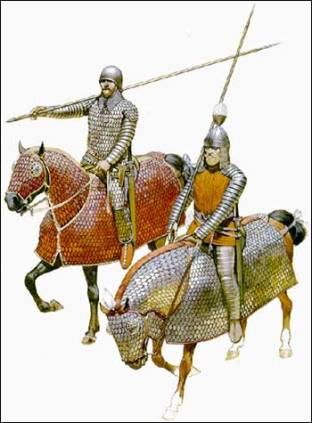Roads are important in history. Cultures become portable and ideas are exchanged across vast distances when good roads are available. Major trading routes were the interstate highways of antiquity. You might remember learning about the “Silk Road” in school. Your class might even have spent a couple of days discussing how important it was for China to get their expensive and highly prized silk fabrics all the way to Rome. (Like getting the latest iPhone shipped to the Apple Stores on time.) But have you heard of the Persian Royal Road that predates the better known Silk Road?
 Treasures of Dodrazeb: The Origin Key is an historical sword-and-science fantasy adventure. Click here to read an excerpt.
Treasures of Dodrazeb: The Origin Key is an historical sword-and-science fantasy adventure. Click here to read an excerpt.
Even though there’s no road to Dodrazeb, a third-century invading Persian warrior becomes obsessed with the strange isolated kingdom that possesses incredible technology, including methods for communicating over vast distances that are familiar in modern times. Ancient Dodrazeb’s puzzling choice to hide from the world pulls him deeper into layers of mysteries as its sly princess does everything she can to expel the invaders. What are the Dodrazebbians so desperate to keep hidden?
Get your copy on Amazon.com! Available in both e-book and paperback.
 The Chinese began making silk fabrics around the year 2700 BCE. Reserved exclusively for use in their imperial court, methods for creating silk were kept secret for more than 3,000 years. But silks showed up in other parts of the world as the Chinese traded it extensively with their nearest neighbors and used it as diplomatic gifts. Early in the first century BCE, silk became prized in the Roman Empire as a rare and exotic luxury. Trading routes were developed and expanded to move the goods from East to West. From Rome, the desire for silk was introduced to other western cultures.
The Chinese began making silk fabrics around the year 2700 BCE. Reserved exclusively for use in their imperial court, methods for creating silk were kept secret for more than 3,000 years. But silks showed up in other parts of the world as the Chinese traded it extensively with their nearest neighbors and used it as diplomatic gifts. Early in the first century BCE, silk became prized in the Roman Empire as a rare and exotic luxury. Trading routes were developed and expanded to move the goods from East to West. From Rome, the desire for silk was introduced to other western cultures.
The silk trade was important in moving people and products back and forth across Asia, but it wasn’t the only product in demand. Textiles, spices, grain, fruits and vegetables, furs, tools, religious objects, art, precious stones, and much more made the network of Silk Roads well-travelled through the Middle Ages and into the 19th century. Merchants and traders could choose from different routes that crossed Eastern Europe, the Middle East, Central Asia and the Far East. There were also maritime routes which shipped goods from China and South East Asia through the Indian Ocean to Africa, India, and the Near East.
 Much more was exchanged along the Silk Roads than just sought after trade goods. The trade routes connected major cities and civilizations, making cultural interaction necessary. Languages and customs were understood and adopted to make buying and selling possible. Religions and cultures developed and influenced each other because knowledge about science, arts, literature, crafts, and technologies was shared across the Silk Roads. By the way, scientists and historians now widely believe that the route was a primary way that the Black Death plague bacteria moved westward into Europe.
Much more was exchanged along the Silk Roads than just sought after trade goods. The trade routes connected major cities and civilizations, making cultural interaction necessary. Languages and customs were understood and adopted to make buying and selling possible. Religions and cultures developed and influenced each other because knowledge about science, arts, literature, crafts, and technologies was shared across the Silk Roads. By the way, scientists and historians now widely believe that the route was a primary way that the Black Death plague bacteria moved westward into Europe.
 Before the network of Silk Road trading routes, there was the Persian Royal Road which would become one of the main arteries of the Silk Road. Before his death circa 529 BCE, Cyrus the Great had conquered a vast amount of territory, uniting many small and large kingdoms and peoples under his rule. His Achaemenian Empire survived for more than two centuries due to his willingness to support local customs and religions of the people he conquered.
Before the network of Silk Road trading routes, there was the Persian Royal Road which would become one of the main arteries of the Silk Road. Before his death circa 529 BCE, Cyrus the Great had conquered a vast amount of territory, uniting many small and large kingdoms and peoples under his rule. His Achaemenian Empire survived for more than two centuries due to his willingness to support local customs and religions of the people he conquered.
When Darius the Great (521-485 BC) rose to power, he realized the Empire needed efficient organization. To prevent his territorial governors from gaining enough power to overthrow him, Darius appointed a separate military commander for each territory. Darius monitored his governors and commanders by using imperial spies. These “king’s ears” kept tabs on both and reported back to Darius through the postal service. The Empire was connected by a network of Royal Roads with stations spaced a day’s travel apart. Like the Silk Road that came later, these routes promoted cultural interaction, uniting disparate peoples in the far-flung Persian Empire.
 The Persian Royal Road ran from Susa, in north Persia (modern Iran) to the Mediterranean Sea in Asia Minor (modern Turkey) a distance of more than 1,600 miles. The postal stations at regular intervals along the route provided fresh horses for envoys to quickly deliver messages throughout the empire and inspired the famous line “Neither snow nor rain nor heat nor gloom of night stays these couriers from the swift completion of their appointed rounds.” (see my post Ancient Persia’s Pony Express) Relay messengers could traverse the entire road in a mere nine days, sometimes only seven or eight. Normal travel time for caravans or casual travelers was about three months.
The Persian Royal Road ran from Susa, in north Persia (modern Iran) to the Mediterranean Sea in Asia Minor (modern Turkey) a distance of more than 1,600 miles. The postal stations at regular intervals along the route provided fresh horses for envoys to quickly deliver messages throughout the empire and inspired the famous line “Neither snow nor rain nor heat nor gloom of night stays these couriers from the swift completion of their appointed rounds.” (see my post Ancient Persia’s Pony Express) Relay messengers could traverse the entire road in a mere nine days, sometimes only seven or eight. Normal travel time for caravans or casual travelers was about three months.
The Persian Royal Road was so impressive that Alexander the Great used it in his invasion and conquest of the Persian empire in 334 BCE. Never underestimate the importance of good roads—and how they can be used.
Sources
https://www.thoughtco.com/royal-road-of-the-achaemenids-172590
http://www.livius.org/articles/concept/royal-road/
https://en.unesco.org/silkroad/about-silk-road
https://www.britannica.com/topic/Silk-Road-trade-route
https://www.ancient.eu/Silk_Road/
https://searchinginhistory.blogspot.com/2014/04/royal-road-highway-of-persian-empire.html

 Even though it set speed records for mail delivery and became a well-loved and thoroughly romanticized piece of historical lore, the Pony Express was only in operation for 19 months. In that brief time, it failed to secure a lucrative government mail contract and never turned a profit. Between hostile Native Americans and the completion of the transcontinental telegraph system, the Pony Express was driven out of business and became obsolete in October of 1861.
Even though it set speed records for mail delivery and became a well-loved and thoroughly romanticized piece of historical lore, the Pony Express was only in operation for 19 months. In that brief time, it failed to secure a lucrative government mail contract and never turned a profit. Between hostile Native Americans and the completion of the transcontinental telegraph system, the Pony Express was driven out of business and became obsolete in October of 1861. So, just how did that famous phrase come to be associated with the U.S. Postal Service? The unofficial motto is inscribed in granite over the entrance of the James A. Farley building at Eighth Avenue and 33rd Street in New York City, right in the middle of Manhattan. Back in the early twentieth century, the architectural firm of McKim, Mead & White was chosen to design the New York General Post Office building. Construction began in 1912 and it was opened to the public in 1914. The building was doubled in size in 1934 and its name was changed to honor Postmaster General James A. Farley.
So, just how did that famous phrase come to be associated with the U.S. Postal Service? The unofficial motto is inscribed in granite over the entrance of the James A. Farley building at Eighth Avenue and 33rd Street in New York City, right in the middle of Manhattan. Back in the early twentieth century, the architectural firm of McKim, Mead & White was chosen to design the New York General Post Office building. Construction began in 1912 and it was opened to the public in 1914. The building was doubled in size in 1934 and its name was changed to honor Postmaster General James A. Farley. William Mitchell Kendall was one of the architects. Kendall, who frequently read classic Greek literature for pleasure, had grown up in a wealthy household with a father who was a scholar of the classics. He selected a passage (translated by Professor George Herbert Palmer of Harvard University) from book 8, paragraph 98, of The Persian Wars by the ancient Greek historian Herodotus (c 484–c 425 BCE). The Post Office Department agreed that Kendall’s slight modification of the original translation was suitable for the building, and approved it.
William Mitchell Kendall was one of the architects. Kendall, who frequently read classic Greek literature for pleasure, had grown up in a wealthy household with a father who was a scholar of the classics. He selected a passage (translated by Professor George Herbert Palmer of Harvard University) from book 8, paragraph 98, of The Persian Wars by the ancient Greek historian Herodotus (c 484–c 425 BCE). The Post Office Department agreed that Kendall’s slight modification of the original translation was suitable for the building, and approved it.